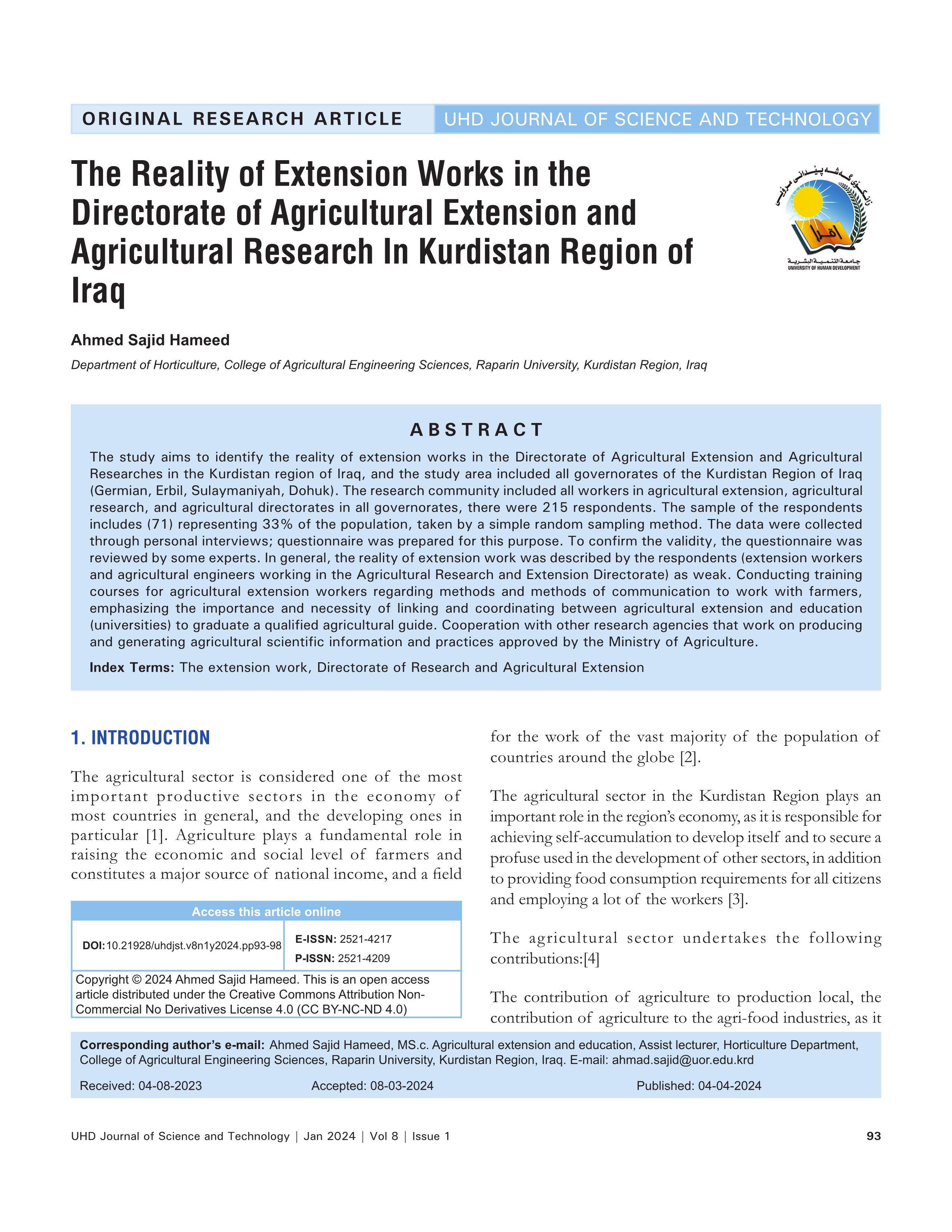The Reality of Extension Works in the Directorate of Agricultural Extension and Agricultural Research In Kurdistan Region of Iraq
DOI:
https://doi.org/10.21928/uhdjst.v8n1y2024.pp93-98Keywords:
The extension work, Directorate of Research and Agricultural ExtensionAbstract
The study aims to identify the reality of extension works in the Directorate of Agricultural Extension and Agricultural Researches in the Kurdistan region of Iraq, and the study area included all governorates of the Kurdistan Region of Iraq (Germian, Erbil, Sulaymaniyah, Dohuk). The research community included all workers in agricultural extension, agricultural research, and agricultural directorates in all governorates, there were 215 respondents. The sample of the respondents includes (71) representing 33% of the population, taken by a simple random sampling method. The data were collected through personal interviews; questionnaire was prepared for this purpose. To confirm the validity, the questionnaire was reviewed by some experts. In general, the reality of extension work was described by the respondents (extension workers and agricultural engineers working in the Agricultural Research and Extension Directorate) as weak. Conducting training courses for agricultural extension workers regarding methods and methods of communication to work with farmers, emphasizing the importance and necessity of linking and coordinating between agricultural extension and education (universities) to graduate a qualified agricultural guide. Cooperation with other research agencies that work on producing and generating agricultural scientific information and practices approved by the Ministry of Agriculture.
References
S. Sultan. “The preferred guiding methods for farmers in Al- Hariq Governorate in the Kingdom of Saudi Arabia for Agricultural Sciences”. The Journal of Animal and Plant, vol. 7, no. 1, pp.20-33, 2008.
T. M. Salih and N. Abdullah. “The reality of using extension methods by workers in agricultural extension in Nineveh Governorate and its relationship to some variables”. Al-Rafidain Agriculture Journal, vol. 39, no. 2, 2011.
A. Khalidi. “The reality of agricultural extension workers in Tartous”. Tishreen University Journal of Scientific Studies and Research, vol. 29, no. 2, pp. 55-68, 2011.
A. A. Hassan. “The Reality of the Extension Activities of the Extension Centers in the Governorates of Duhok, Erbil and Sulaymaniyah, and the Obstacles in Performing their Educational Role”. PhD Dissertation, University of Mosul, Iraq, 2007.
A. Hafeez, I. Muhammad and H. Bahi. “Methods of Scientific Research and Statistical Analysis in the Educational, Psychological and Mathematical Fields”. Dar Al-Kuttab for Printing and Publishing, Saudi Arabia, 2000.
A. G. Zijp and W. Byerlee. “Rural Extension and Advisory Services”. World Bank, Washington, 2004.
J. R. Feder and G. Andeson. “Rural Extension Services”. World Bank, Washington, 2003.
J. R. Feder, G. Willett and A. G. Zijp. “Improving Agricultural Extension. A Reference Manual”. FAO Rome; 1997.
R. M. Ismail. “The reality of the extension planning process in the Baghdad agricultural directorate”. Iraqi Journal of Agricultural Sciences, vol. 44, no. 6, pp. 719-728, 2013.
N. Riad. “Fundamentals of Modern Agricultural Extension”. University of Damascus, Syria, 2002.
W. Peterson. “Method for Planning Effective Linkages”. ISNAR, Netherlands, 2004.
R. Ramirez. “Understanding Farmers’ Communication Networks: Combining PRA with Agricultural Knowledge Systems Analysis”. Gatekeeper Series No. 66. IIED, London, 2003.
W. Rivera and M. K. Qamar. “Agricultural and Rural Extension Worldwide: Options for Institutional Reform in the Developing Countries”. FAO, Rome, p. 12, 2001.
H. Subhi. “Some Factors Affecting the Performance of Extension Agents in some Governorates of the Arab Republic of Egypt”. PhD Dissertation, Cairo University, Egypt, 1994.
W. G. Hubbard and L. R. Sandman. “Using Diffusion of Innovation Concepts for Improved Program Evaluation Extension, A Reference Manual”. FAO, Rome, 2007.

Downloads
Published
How to Cite
Issue
Section
License
Copyright (c) 2024 Ahmed Sajid Hameed

This work is licensed under a Creative Commons Attribution-NonCommercial-NoDerivatives 4.0 International License.


